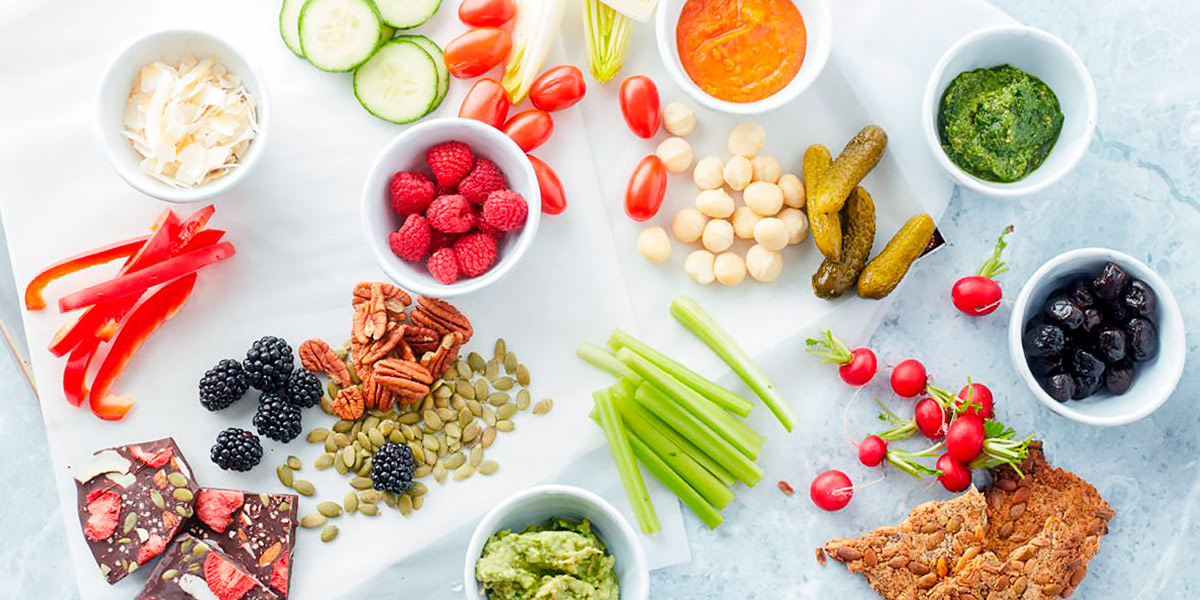
If you are unfamiliar with veganism, you might be wondering what foods to eat. These tips will help you get started with a vegan diet. While eating lots of fresh veggies and lean meats is possible, you should avoid processed foods. Other than fruits and nuts you can also include legumes or soy products. Vegan meal plans should also include seasonal and local ingredients.
Vegetables
A vegan meal plan should include vegetables. These vegetables are rich in fiber and also provide important amounts of iron and vitamin A. A good selection of whole grains and protein-rich plant foods is also important. There are many ways to make your vegan meal plan more simple. You can try these tips. You can try these tips, regardless of your dietary preferences.

Legumes
It's not difficult to include more legumes into your vegan meals. It's a great way of adding variety to your meals. These delicious plant-based meals are high in protein and fiber. You can either add them to your favorite meal or use them as a side. They are also excellent for preserving leftovers. To enjoy their wonderful taste, you don’t have to be an expert chef.
Soy products
Soy products can be a great way for vegans to get high-quality protein. They are a great source of fiber, omega-3 fatty acids, and vitamins. Soy contains phytoestrogens, which are similar to the human hormone estrogen but are weaker. Soy is a good choice for vegans as well. But, it is important to know the potential risks associated with too much soy.
Nuts
Include plenty of nuts and seeds in your vegan meal plan. These are great sources of energy, and they contain essential fatty acid. They are also very high in fiber, and contain a lot of protein. Pistachios are a good example of a nuts that have as much protein than an egg. The body also benefits from the combination of fat, protein, and fiber. The long-term health benefits of nuts and seeds include antioxidants. Some of these antioxidants and anti-inflammatory compounds include carotenoids, phenolic acids, phytosterols, flavonoids, and proanthocyanidins.
Nutritional yeast
Using nutritional yeast in your vegan meal plan has many benefits. It is rich in B vitamins, low in carbs, and high in fiber. It slowly absorbs into the bloodstream and doesn't cause any changes in blood sugar. A spoonful of nutritional yeast can be added to your daily intake of B vitamins. It's a great way to get your daily recommended dose of B vitamins. Why not add it to your vegan meal plan?

Vegetable-based breakfasts
Vegetable-based Breakfasts can be delicious, nutritious and tasty. They can also be quick and simple. You have a wide range of options for vegan breakfasts, no matter if you are a beginner or an expert. It's possible that you are wondering how to create new vegan breakfast recipes if your vegan diet is just beginning. For those who just want to start a plant-based diet, we have some helpful tips and a 3-day meal planning.
FAQ
What is the difference of a virus from a bacteria?
A virus, a microscopic organism that can not reproduce outside of its host cells, is called a virus. A bacterium is an organism that splits itself in two. Viruses can be as small as 20 nanometers, while bacteria can grow up to 1 micron.
Viruses are usually spread through contact with infected bodily fluids, including saliva, urine, semen, vaginal secretions, pus, and feces. Bacteria are often spread via direct contact with contaminated surfaces and objects.
Viral infections can be transmitted through skin cuts, scrapes and bites. They can also penetrate the nose, lips, eyes and ears, vagina,rectum, or anus.
Bacteria can enter our bodies through wounds, cuts, scrapes, burns, insect stings, or other breaks in our skin. They can also be introduced to our bodies by food, water and soil.
Both bacteria as well as viruses can cause illness. Viruses can not multiply in the host. So they only cause illnesses when they infect living cells.
Bacteria can multiply within their hosts and cause illness. They can even invade other parts of the body. Antibiotics are needed to eliminate them.
What should I eat?
You should eat lots of vegetables and fruits. They are rich in vitamins, minerals, and help to strengthen your immune system. Vegetables and fruits are high in fiber which helps to digest and fill you up. Include at least five portions of fruit and vegetables per day.
Water is essential for your body. Water flushes out toxins and helps you feel full between meals. Drink about eight glasses each day.
Choose whole grains over refined ones. Whole grains contain all of their nutrients, including B vitamins and iron. Refined grain has lost some of its nutrition.
Avoid sugary drinks. Sugary drinks have empty calories and are a major contributor to obesity. Instead, you can opt for water or milk, as well as unsweetened herbal teas.
Avoid fast food. Fast food has little nutritional value. Although it may taste delicious, fast food won't provide you with the energy you need for your daily activities. Instead, stick to healthier options like soups and sandwiches, pasta, and salads.
Limit your alcohol intake. You should limit your alcohol intake as it contains empty calories and can lead to poor nutrition. Limit the number of alcoholic beverages you consume per week to no more that two.
Red meat consumption should be reduced. Red meats have high levels of cholesterol and saturated fat. Choose lean cuts such as beef, pork and lamb, chicken, fish, or turkey.
Do I have to count calories?
You may be wondering "what is the best diet for you?" or "is counting calories necessary?" This depends on several factors like your current health and personal goals. Your preferences and overall lifestyle.
The Best Diet for Me - Which One is Right For You?
My personal health, goals, lifestyle and preferences will all influence the best diet. There are many good and bad diets. Some diets work for some people, while others are not. So what do I do? What can I do to make the right decision?
These are the questions this article will answer. It begins with an overview of the different diets today. Next, we will discuss the pros & cons of each kind of diet. We'll then discuss how to choose which one is best for you.
Let's begin by briefly reviewing the different types and diets.
Diet Types
There are three main types. Low fat, high protein, or ketogenic. Let's briefly discuss them below.
Low Fat Diets
A low-fat diet is a diet that reduces the amount fats consumed. This is achieved by reducing saturated fat intake (butter, cream cheese etc.). and replacing them with unsaturated fats (olive oil, avocados, etc.). A low fat diet is often recommended for those who want to lose weight quickly and easily. This diet can cause constipation, heartburn, and stomach problems. In addition, it may lead to vitamin deficiencies if a person doesn't get enough vitamins from their food.
High Protein Diets
High protein diets are known to restrict carbohydrate intake and promote the consumption of protein. These diets usually have higher amounts of protein than other diets. These diets are intended to increase muscle mass and reduce calories. Unfortunately, they can't provide adequate nutrition for those who eat regularly. They can also be very restrictive so they may not be suitable for everyone.
Ketogenic Diets
These diets are also known under the name keto diets. They are high-fat and low in carbs and protein. They are typically used by athletes and bodybuilders because they allow them to train harder and longer without getting tired. They do require strict compliance to avoid any side effects like fatigue, headaches, nausea, and headaches.
What's the problem with BMI?
BMI stands to Body Mass Index. This refers to the measurement of body weight based on height. This formula calculates BMI.
Divide the weight in kilograms by the height in meters squared.
The score is expressed as a number between 0 and 25. A score of 18.5 indicates that you are overweight and a score of 23 indicates that you are obese.
A person who is 100kg and 1.75m tall will have a 22 BMI.
Is cold a sign of a weak immune response?
Cold causes a decrease in immune system strength. This is because white blood cells are less effective at fighting infection. You will feel less pain if you are cold.
How do I get enough vitamins?
Your diet can provide most of your daily requirements. Supplements are an option if you are low in any vitamin. A multivitamin can contain all the vitamins that you need. You can also get individual vitamins at your local drugstore.
If you are concerned about getting enough nutrients, talk to your doctor about what foods contain the best sources of vitamins. For example, dark green leafy vegetables such as spinach, broccoli, kale, collard greens, turnip greens, mustard greens, bok choy, romaine lettuce, arugula, and Swiss chard are rich in vitamins K and E. Other good sources include oranges, tomatoes, strawberries, cantaloupe, carrots, sweet potatoes, pumpkin, and squash.
If you are not sure how much vitamin you should be consuming, ask your doctor. The doctor will determine the proper dosage based upon your medical history as well as your current health.
Statistics
- Extra virgin olive oil may benefit heart health, as people who consume it have a lower risk for dying from heart attacks and strokes according to some evidence (57Trusted Source (healthline.com)
- According to the 2020 Dietary Guidelines for Americans, a balanced diet high in fruits and vegetables, lean protein, low-fat dairy and whole grains is needed for optimal energy. (mayoclinichealthsystem.org)
- WHO recommends consuming less than 5% of total energy intake for additional health benefits. (who.int)
- WHO recommends reducing saturated fats to less than 10% of total energy intake; reducing trans-fats to less than 1% of total energy intake; and replacing both saturated fats and trans-fats to unsaturated fats. (who.int)
External Links
How To
How to Keep Your Body Healthy
This project had the main purpose of providing suggestions for how to maintain your health. To maintain good health, the first step is to learn what you can do. This was necessary because we needed to know what is best for us. We looked at many different methods that people tried to improve their physical and mental health. Finally, we came up with some tips that would help us stay healthier and happier.
We started by looking at what food we eat. We discovered that some foods are not good for us and others are better. Sugar, for example, is known to be very unhealthy as it can lead to weight gain. On the other hand, fruits and vegetables are good for us because they contain vitamins and minerals that are essential for our bodies.
Next, exercise was discussed. Exercise strengthens our bodies and gives us more energy. Exercise makes us happy. There are many types of exercise that you can do. Some examples include walking, running, swimming, dancing, playing sports, and lifting weights. Yoga is another way we can increase our strength. Yoga is great for flexibility and improving breathing. We should avoid junk food and drink lots of water if we are trying to lose weight.
Finally, let's talk about sleeping. Sleep is an essential part of our daily lives. When we don't get enough sleep, we tend to become tired and stressed. This leads to problems such as headaches, back pain, depression, heart disease, diabetes, and obesity. It is essential that we get sufficient sleep in order to keep our health good.